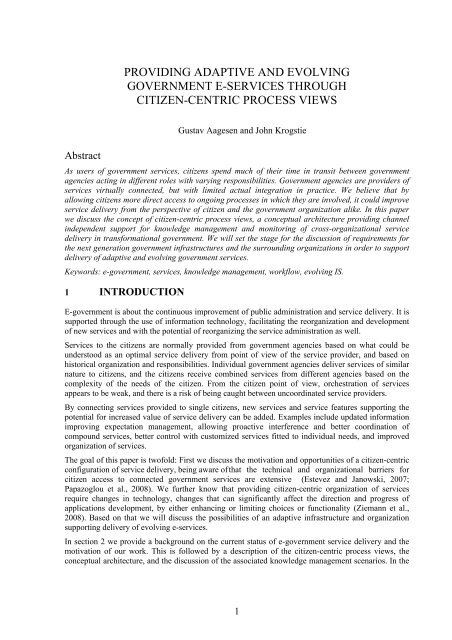Multi-channel provisioning of public services - Department of ...
Multi-channel provisioning of public services - Department of ...
Multi-channel provisioning of public services - Department of ...
You also want an ePaper? Increase the reach of your titles
YUMPU automatically turns print PDFs into web optimized ePapers that Google loves.
PROVIDING ADAPTIVE AND EVOLVING<br />
GOVERNMENT E-SERVICES THROUGH<br />
CITIZEN-CENTRIC PROCESS VIEWS<br />
Abstract<br />
Gustav Aagesen and John Krogstie<br />
As users <strong>of</strong> government <strong>services</strong>, citizens spend much <strong>of</strong> their time in transit between government<br />
agencies acting in different roles with varying responsibilities. Government agencies are providers <strong>of</strong><br />
<strong>services</strong> virtually connected, but with limited actual integration in practice. We believe that by<br />
allowing citizens more direct access to ongoing processes in which they are involved, it could improve<br />
service delivery from the perspective <strong>of</strong> citizen and the government organization alike. In this paper<br />
we discuss the concept <strong>of</strong> citizen-centric process views, a conceptual architecture providing <strong>channel</strong><br />
independent support for knowledge management and monitoring <strong>of</strong> cross-organizational service<br />
delivery in transformational government. We will set the stage for the discussion <strong>of</strong> requirements for<br />
the next generation government infrastructures and the surrounding organizations in order to support<br />
delivery <strong>of</strong> adaptive and evolving government <strong>services</strong>.<br />
Keywords: e-government, <strong>services</strong>, knowledge management, workflow, evolving IS.<br />
1 INTRODUCTION<br />
E-government is about the continuous improvement <strong>of</strong> <strong>public</strong> administration and service delivery. It is<br />
supported through the use <strong>of</strong> information technology, facilitating the reorganization and development<br />
<strong>of</strong> new <strong>services</strong> and with the potential <strong>of</strong> reorganizing the service administration as well.<br />
Services to the citizens are normally provided from government agencies based on what could be<br />
understood as an optimal service delivery from point <strong>of</strong> view <strong>of</strong> the service provider, and based on<br />
historical organization and responsibilities. Individual government agencies deliver <strong>services</strong> <strong>of</strong> similar<br />
nature to citizens, and the citizens receive combined <strong>services</strong> from different agencies based on the<br />
complexity <strong>of</strong> the needs <strong>of</strong> the citizen. From the citizen point <strong>of</strong> view, orchestration <strong>of</strong> <strong>services</strong><br />
appears to be weak, and there is a risk <strong>of</strong> being caught between uncoordinated service providers.<br />
By connecting <strong>services</strong> provided to single citizens, new <strong>services</strong> and service features supporting the<br />
potential for increased value <strong>of</strong> service delivery can be added. Examples include updated information<br />
improving expectation management, allowing proactive interference and better coordination <strong>of</strong><br />
compound <strong>services</strong>, better control with customized <strong>services</strong> fitted to individual needs, and improved<br />
organization <strong>of</strong> <strong>services</strong>.<br />
The goal <strong>of</strong> this paper is tw<strong>of</strong>old: First we discuss the motivation and opportunities <strong>of</strong> a citizen-centric<br />
configuration <strong>of</strong> service delivery, being aware <strong>of</strong> that the technical and organizational barriers for<br />
citizen access to connected government <strong>services</strong> are extensive (Estevez and Janowski, 2007;<br />
Papazoglou et al., 2008). We further know that providing citizen-centric organization <strong>of</strong> <strong>services</strong><br />
require changes in technology, changes that can significantly affect the direction and progress <strong>of</strong><br />
applications development, by either enhancing or limiting choices or functionality (Ziemann et al.,<br />
2008). Based on that we will discuss the possibilities <strong>of</strong> an adaptive infrastructure and organization<br />
supporting delivery <strong>of</strong> evolving e-<strong>services</strong>.<br />
In section 2 we provide a background on the current status <strong>of</strong> e-government service delivery and the<br />
motivation <strong>of</strong> our work. This is followed by a description <strong>of</strong> the citizen-centric process views, the<br />
conceptual architecture, and the discussion <strong>of</strong> the associated knowledge management scenarios. In the<br />
1
















